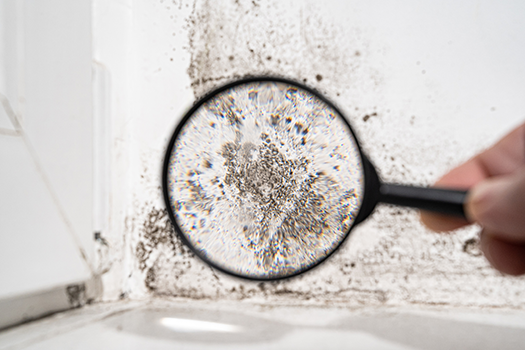Mold growth in your home is never something you want. Unfortunately, it’s a very common occurrence and, if left unchecked, can cause serious property damage and even health issues. There are thousands of types of mold, but the most common household types are Stachybotrys Chartarum (Black Mold), Cladosporium, and Aspergillus, all of which can be harmful to your health. Respiratory conditions, allergies, headaches, and even cancer have been linked to mold exposure. So how do you know if you’re living with mold? Here are a few tips for identifying mold in your home.
Take a Look
One of the easiest, and most obvious, ways to detect mold in your home is to see it. Mold is often mistaken for dirt, so it’s important to examine and clean dark spots immediately. Black Mold is the easiest to spot because of its black, slimy texture. Other molds may appear green, yellow or even pink in color, and could have a fuzzy texture. Ruling out dust and dirt is step number one to identifying a mold problem.
Examine Plumbing
Since mold needs moisture to grow, the plumbing in your home is a good place to start. Cracks around faucets and fixtures are a breeding ground for colonies. Additionally, mold can grow if pipes are loose or have slow drips. Check all your pipes and valves, as well as the areas around them, for signs of mold.
Use Your Nose
Mold and mildew tend to give off musty odors which are usually detectable. Mold can have an earthy smell like rotting leaves or damp dirt. If your home is smelling musty or damp, chances are there’s mold growing somewhere. If you notice a musty odor when your heat or air conditioning kicks on, it’s likely mold growing in the HVAC system.
Check Crevices
Mold colonies love to grow in dark, damp crevices and porous surfaces. These could include ceiling tiles, thick carpets, furniture cushions and pillows, grout, and cracks in porcelain sinks and bathtubs. Check these areas and thoroughly clean and seal them if you suspect mold growth. Note that if mold is growing in fabrics like furniture or carpets, you will likely need to replace them.
Health Factors
A subtle but crucial indicator of mold in your home could be your family’s overall health. If you or anyone in your household has been experiencing breathing difficulties, prolonged illness, allergy symptoms or headaches, it may be mold. These health risks are why it’s so important to promptly address mold and never let it go unchecked in your home.
Contextual Factors
It’s pretty easy to determine if mold is going to be a problem in your home just by looking at the factors of your environment. The recent flooding in New Jersey makes the mold risk higher right now. Other factors could include prolonged periods of intense humidity in the summer, lots of rain or snow, and outbreaks of mold in nearby houses. Examining these contextual factors can help you determine if your home is at risk for a mold outbreak.
So if you’re identifying mold in your home, what do you do now? Never try to conquer mold without the proper tools, protection, and products. Always wear protective gloves and facial covering when messing with mold and chemicals to treat it. Or, go with the safest and most effective option: contact the mold remediation experts at Pathogend of New Jersey. We have the training and tools to effectively battle the mold in your home and keep your family safe!







